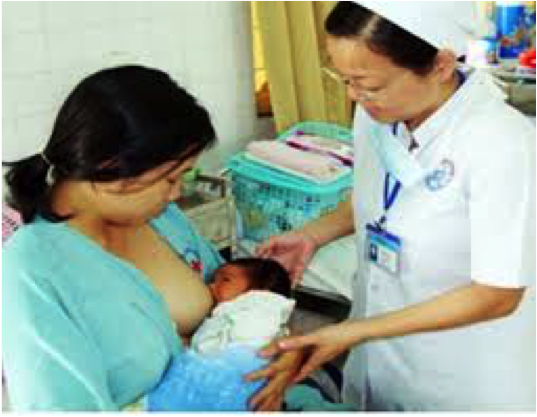By Phuong Nguyen, Sunny Kim, and Purnima Menon
Research shows that exclusive breastfeeding improves child growth and development, reduces infant mortality from common childhood illnesses such as diarrhea or pneumonia, and helps mothers recover quicker from childbirth, as well as providing other health and emotional benefits to both mothers and children. That’s why the World Health Organization recommends that mothers worldwide exclusively breastfeed infants during their first six months, and continue until they reach two years or older with appropriate complementary feeding.
However, in developing countries, the first months of infancy pose particular obstacles; only 39 percent of infants are exclusively breastfed to six months of age. A program called Alive & Thrive (A&T), funded by the Bill & Melinda Gates Foundation and the governments of Canada and Ireland, addresses this difficult problem. To mark World Breastfeeding Week (Aug. 1-7), here is a look at A&T’s performance in three countries: Bangladesh, Ethiopia, and Vietnam.
Why do so many mothers struggle to breastfeed in the first months of infancy? During that time, they face a barrage of challenges: Finding time to breastfeed during their daily chores, refraining from giving something other than breast milk to placate or distract a fussy baby, returning to work, difficulties with pumping breast milk, having to discourage family members or elders from feeding the baby, etc. To overcome these obstacles, efforts to promote and support this essential and cheap life-saving practice must be continuous and comprehensive, reaching families, communities, and policy-makers.
A&T has achieved positive results promoting infant and young child feeding (IYCF) in rural communities during this crucial six-month period and throughout the first two years of an infant’s life. IFPRI closely tracked its performance in Bangladesh, Ethiopia, and Vietnam from 2010 to 2014. During that time, the program reached more than 16 million children under two years old, and developed large-scale program models that can be replicated most anywhere in the world.
In the three countries, A&T worked with government and non-governmental partners and through existing health systems to deliver a comprehensive package of interventions—including counseling and communication, community mobilization, and media outreach targeted at policymakers.
In Bangladesh, A&T formed a national IYCF alliance with 25 partners, including the Institute of Public Health Nutrition, government agencies, and NGOs. BRAC, the Bangladesh-based global NGO, ran interventions in 50 rural sub-districts through its national Essential Health Care program. BRAC workers regularly visited the homes of pregnant women and mothers with children up to two years old to provide age-targeted IYCF counseling and encourage other family members to support the mother’s efforts. The BRAC workers advised community leaders about IYCF and held community demonstrations. Seven TV spots about good IYCF practices were broadcast nationally. The program also established a capacity-building program for journalists, and held national and district-level meetings and workshops for opinion leaders. An IFPRI analysis showed that in intensive intervention areas, exclusive breastfeeding rates increased from 49 to 88 percent over four years (in areas with less intensive programs, the effect was less pronounced).
In Ethiopia, breastfeeding rates are higher than in Bangladesh or in Vietnam, but overall IYCF practices are still poor. A&T provided information and counseling to mothers and caregivers primarily through the Federal Ministry of Health’s flagship Health Extension Program throughout Ethiopia’s four most populous regions: Amhara, Oromia, SNNPR, and Tigray, using its large network of female health extension workers and teams of community health volunteers. They held village gatherings to discuss breastfeeding and demonstrate how to prepare nutritious complementary foods. A&T also partnered with various NGOs, faith-based organizations, and women’s associations to launch a radio campaign. Early initiation of breastfeeding there increased from 67 to 82 percent, while exclusive breastfeeding rates rose significantly from 72 to 83 percent.
Vietnam is a rapidly industrializing country with stubbornly low breastfeeding rates. There, A&T worked with the Ministry of Health, the National Institute of Nutrition, UNICEF and other agencies. Implementing partner Save the Children worked with the government to establish 1,032 “social franchises” in clinics, hospitals, and other health facilities in 15 of the country’s 63 provinces. The franchises provided individual and group counseling sessions from the third trimester of pregnancy until children turned two. A&T also worked with partners to strengthen two national policies: the Labor Code, which governs paid maternity leave, and the Advertisement Law, which governs the marketing of breast milk substitutes. A media campaign also promoted behavior change via TV spots, loud speakers, and digital media. In intensive intervention areas, exclusive breastfeeding rates increased threefold from 19 to 58 percent, less so in non-intensive areas.
Further study is needed to understand what happens to children who are not exclusively breastfed, and how to increase reach and sustain behavior change over time and across generations. But intervention programs such as A&T demonstrate that a comprehensive approach to improve breastfeeding practices can be delivered with impact and at scale in different contexts worldwide. (Since 2014, A&T has begun working in Burkina Faso, India, and Southeast Asia, and diversified its operations in Bangladesh and Ethiopia.)
Phuong Nguyen and Sunny Kim are Research Fellows and Purnima Menon a Senior Research Fellow in IFPRI’s Poverty, Health, and Nutrition Division. Nguyen and Kim are based in Washington, D.C., and Menon in New Delhi.







